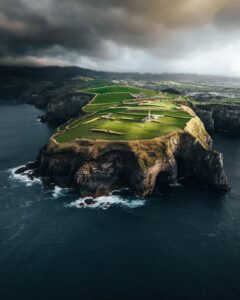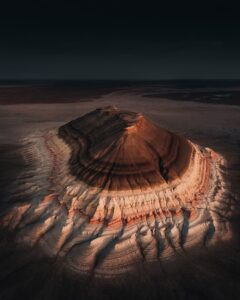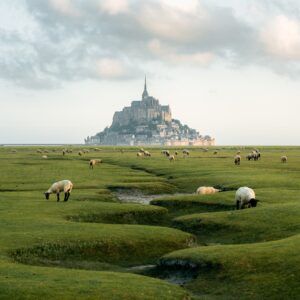
Photo tour in Azores, Portugal
Join us in the Azores for a unique photo tour, where you’ll elevate your creative skills with expert guidance from Ronald Soethje, Bruno Ázera, and Nomadict.
Our first interview of 2020 was with Alex Stead, a travel and commercial photographer based in UK with more than 12 years of experience and 1M followers. Skipping classes and dropping out of university doesn’t always indicate a successful future career, but in this case it worked. Starting with small brands, Alex is now also working with brands worldwide such as Mercedes, Lufthansa and Nikon. To reach this, “you have to be proactive all the time!” Networking is key, he says, and having a business mindset and knowing how to pitch to brands is very important as well.
Essential to Alex is putting aside time and money each year to dedicate it to something that you really love doing. Photographing can be a hobby, but to stay creative, motivated and inspired it helps to do some kind of ‘projects’ for yourself rather than for a client. Alex started with wildlife photography, using his own resources. Besides just enjoying it, it helped him improving as well and without having the objective, it also brought him new clients. “Limiting yourself to just fine art landscape for example, narrows down your business and what you can offer” he mentioned. By the way, one of his favorite photos is the one of the lion. If you read the story behind the photo, you will understand why!
When we asked Alex about his editing process, he shared some interesting tactics he’s using himself. For example, he recommends anyone to really understand what effect the tonal curve has on your photo when applying it. For more than a decade Alex has developed a specific style and he was so kind to explain something about that and his approach to shooting, editing and traveling.
For Alex, the best part of traveling is meeting people, he loves working with other creatives and thinks that it’s all about learning from and encouraging each other. This is directly one of the four tips he gave away to all of you who would like to pursue a career in photography.
Curious about the other tips and what he had more to say? Keep reading!
Welcome Alex!
On your website is written: “Alex’s passion for photography began 12 years ago borrowing his father’s camera to shoot his home city, London.” Where did this curiosity for photography come from? And what was it about photography that you liked that much so you kept shooting?
I was always creative at school, I was never really passionate about being indoors or working at a desk. My passion for photography came from when I started studying it at school, I loved how creative you could be. Darkroom, film developing, pinhole photography… A lot of these skills are never learnt by many new photographers in the industry but it’s where my curiosity and passion came from. I kept on shooting after I left school and decided to go to university to study further, although soon it seemed that further education wasn’t for me. I dropped out after one year of university, not because I thought I knew it all and I didn’t need to learn, not at all, but I was being hired by clients and by traveling the world, being out in the field, I learnt 10 times faster than what I could be taught at university. I have never looked back or regret it, I am very happy that the decision I took back then worked out so well.
Within these past 12 years, you have worked yourself towards one of the most followed UK photographers and built a portfolio including both travel and commercial photography, delivering work for many known brands. Can you tell us something about this journey? How did you realize this?
The journey has actually been pretty crazy, I was 19 when I dropped out of uni. Some of the first brands I worked with while I was at university (skipping class to go work with them) were key to helping me build my portfolio. Mercedes, Lufthansa, and Ritz Carlton, to name a few. Even though I was doing small projects with these brands at the time, these lead to larger opportunities with them and other clients. Of course, these brands didn’t become clients overnight; I worked with a lot of small brands first. Connections and networking are everything in photography, emailing, meetings, etc. You have to be very proactive, all the time.
Building a huge following on social media was very important to me at the start. I still value what I have, of course, but it’s not that important to me anymore. The work I produce and the projects I work on are so much more important.
How is travel and commercial photography different from each other for you? How do you experience each of them? Any preference?
I’m lucky enough that most commercial jobs I do actually merge with travel. If I want to go to a destination, I pitch ideas to brands I know or to new brands, depending on the destination. I also get contacted by a lot of brands that want me to shoot their hotel, cars, planes, destinations or products. For example, I did the Nikon Z50 launch this year and we worked for about a month on pre-production. I brought about a team of eight to do the work in Italy together with me. However, I think it’s very important in photography to have projects you feel passionate about, because all commercial travel work is actually really hard. It’s very rewarding but it’s working nonstop to ensure producing the best work possible for the client.
As a professional photographer, being booked by brands worldwide and traveling to different places regularly, how do you balance work/private? Especially focussing on photography, how do you ‘protect’ the photography you do for yourself, freely, besides the photography you do to ‘deliver’ taking into account the specific requests?
This is a hard one, I think putting some time and money aside each year is really important to put it back into what you love. I try do a couple of wildlife projects each year. Recently though I had clients picking up on my wildlife portfolio which I started out of pure enjoyment with my own money and time. So now I’m starting to get work and opportunities in that area as well, which is amazing.
There are many photographers out there nowadays. How would you describe yourself as photographer and how do you make sure you distinguish yourself?
The photography and creative space is a really tough one, I feel I distinguish myself firstly by my work. I feel I have a style, composition and symmetry throughout my images which I feel is recognisable as well. I don’t limit or overextend what I can do in photography. What I mean by this, is that I don’t limit myself to just landscape images, I also work in lifestyles imagery and do video work, which is a great section to be in. Cars, hotels, planes, tourism board etc. All of them want lifestyle imagery as well as landscape. Limiting yourself to just fine art landscape for example, narrows down your business and what you can offer. However, as I said I don’t overextend what I do, I’m not taking on weddings, corporation head shots, or parties.
These are just a few random examples but I hope you see my point. No matter how many pretty or incredible images you take…if you don’t have a business mindset in photography, you aren’t going to have a career. I have very good client relationships and I’m easy to work with. I understand how to reach out and to pitch to brands. Lastly, I work extremely hard, I mostly work seven days a week. On most shootings I work from 5/6AM till 11/12 at night.
Would you like content like this sent to your inbox?
Can you tell us about your editing style and explain your editing process with an example?
Firstly, it starts with the way I shoot. I feel it’s very clean and easy to understand the image. I usually try incorporate symmetry or foreground elements if I can. My editing process is to recreate the moment as I felt I was there. I don’t overkill and I try to keep the editing simple to a point.
For example, this image of the Defender in New Zealand is probably the most over exaggerated edits I would do but it’s how the moment felt. It was pouring with rain for days on the west coast and the greens were just incredible. I use Lightroom and Photoshop to edit and for this I used the tonal curve first. This is such an important tool; I would highly recommend any person to really get to know how this can affect your image.
Also important is using the color calibration, this can really enhance and change your colors far more than Hue, Saturation and Lightness (HSL). Still HSL is important, I used this to remove the blue satiation on the car to create that cold gun metal look. I also use a lot of small adjustments and brushes. Usually when editing, I save a copy of the image so often so I can compare if the change I made makes sense or I shouldn’t do it. Like that it’s really easy to switch between them on your desktop.
What is your approach when it comes to planning your trip and finding your ideal locations?
There is a lot of planning needed for any trip. My latest production was the Nikon Z50 campaign for which had one month of pre-productions! However, that was a large production in Italy for which I had a crew of 8 to 10 on some days so pre-planning was essential. Finding locations for a client or a personal trip is all about spending hours on google maps. It’s such a powerful tool, I have like 360 pin drops and there are random photos from people at most locations in the world. Even some of the most remote! So without going to a location you can get a pretty good idea of what that place is going to be like. I use SunCalc as well, which allows you to see where sunset and sunrise will be.
As a photographer, I am sure that you feel attached to all your photos. All your pictures represent unique moments of your life. However, among your works, do you have any picture that you really like? What is your favorite photo?
One of my favourite photos I’ve taken is of a lion in Tanzania. My friend Tom Archer and I were doing a passionate project for a few days in the Serengeti. This was our final morning before heading home. We started very early as that’s when the wildlife is most active. It was very dark but we came across a pride of lions that had just caught a zebra. We watched the 15+ lions ripping it apart and taking sections away to eat. I was using a 400mm 2.8 at the time. I just love how savage this image is, pure wild nature. The lion looking straight into the camera, and the carcass leading your eye into the image, so powerful. Also, as it was dark, we were using a fairly high ISO which just added a great bit of texture to the image.
What is the most beautiful thing that travel has allowed you to do?
That’s definitely meeting people, a 100%! I love meeting and working with other creatives. Going on a trip for a client or personal trip with a couple of great creatives is so much fun. Learning of each other and pushing each other is what it’s all about!
Is there any artist/photographer who has inspired your art? Can you name three?
So my three got to be Chris Burkard, very inspiring and always pushing the limits in photography. Of course my close friend Davis Paul; such a fun guy to hang out with and we have done so many great projects together. And also Garant Shortstache, I met him in the rockies and we shot together for a bit. He’s such a cool guy and I love his work as well as his way of storytelling.
Probably you have lots of places on your wishlist to visit and photograph! Any new projects coming up or countries you will be visiting soon?
I’ve got a few projects coming up but can’t talk much about them due to clients’ NDA’s. But I can say I’m going to Namibia and South Africa at the start of the year. I honestly often don’t know what the year will bring, I often get emails or calls on very short notice!
Nowadays we see so many young talented artists pursuing a career as a full time travel/landscape photographer. What four pieces of advice would you give them?
I’ve noticed that, in my opinion, photographers aren’t always that sociable people. It’s honestly incredible who you can meet in the most random places. This is related to getting work; I go to a lot of meetings or events to network. Networking is one of the most important things to do to get a successful career.
I know this sort of goes into point one, but go meet up and shoot with other creatives at your level. When saying at your level, I don’t mean it in a bad way at all. But people, including myself when I started out, want to hang out and shoot with some of the biggest creatives while it would be more useful to try reach out to people in a similar stage as you. Most of the time, busy and successful creatives aren’t going to meet with people who’re just starting, unless it’s for teaching purposes (workshops). They also want to learn and shoot with creatives of their own level or higher. Again, it’s not negative or denigrating, it’s just the way it works, not only in photography.
I meet up with a lot of photographers but I’ve been more careful in recent years because I’ve had people who just want to meet me to talk about work, how I get jobs, how I did this or that, asking me to mention them in a story or something.. So it’s nice they want to meet me, but it’s less nice to feel that it’s not really to get to know me as a person, but just to enjoy themselves what they can get. Hopefully you can see why that becomes a bit much at some point.
I think photographers or creatives should never stop learning. There is nothing worse than not improving on your craft and staying where you are as such, no matter how professional you are or how many years you’ve been working. I look at every shooting and every image I take to evaluate what I could have done better. Whether I needed to improve my edit or whether I needed to get a new bit of gear which could make that image even 5% better.. Or whether I made a mistake, cropped something that wasn’t meant to be cropped, should have used another lens, etc. I am my harshest critic.
I remember when I was starting out in photography and trying to make money; I shot the most boring things, like corporation events, to make money. I didn’t make much with these projects but I re-invested what I earned into a new bit of equipment which I thought could help me reach my goal of becoming a travel photographer, like a new filter or a lens. Or I would invest it into travelling to a place like Iceland to build my portfolio.

Join us in the Azores for a unique photo tour, where you’ll elevate your creative skills with expert guidance from Ronald Soethje, Bruno Ázera, and Nomadict.

In this article, Forest shares how years of chasing scale, silence, and raw landscapes shaped his approach to photography, from the deserts of Kazakhstan to the volcanic ridges of Iceland. He talks about how he uses light, texture, and vast negative space to create images that feel both intimate and overwhelming.

Simon shares the journey behind his photography, from early inspirations to field techniques, editing, and the story of the winning shot that shaped his path.

In this article, Miro shares how his love for cinematic music evolved into a deep passion for photography and how he uses light, color, and atmosphere to turn the streets of Prague into living film scenes.

In this article, Stefanie reveals how her background in physics sparked her passion for astrophotography and how she blends science with creativity to capture the beauty of the night sky. Readers will discover her approach to color, contrast, and editing, as well as her aurora photography workflow.

Spanish photographer Yhabril captures the profound connection between humans and the mountains that shaped him. Growing up in the Pyrenees, his work bridges outdoor sports, landscapes, and celestial scenes — often blending athletes, moonlight, and wilderness into striking visual stories.
